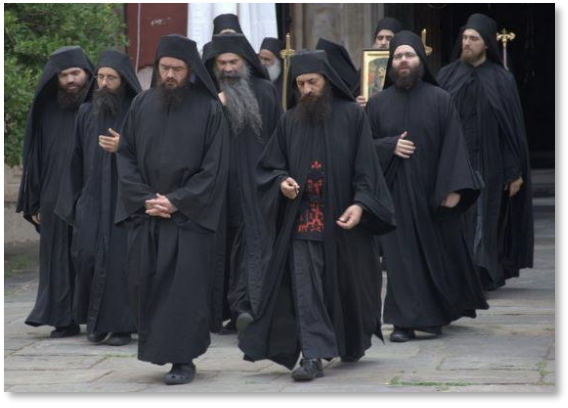Monasticism
Monasticism forms a counterweight to this perennial worldly temptation, for monasticism represents the “angelic life,” a world that though rooted in this age, sets its focus upon the age to come. The seed that would eventually flower into monasticism is found within the New Testament. St. Paul pointed out that the single person had more leisure to pray and seek God than did the married person, since the latter was encumbered by a multitude of earthly cares relating to marriage and child-rearing (see 1 Cor 7:32–36). Not everyone had the charisma of abstinence or the domestic freedom to embrace such a life of singleness (1 Cor 7:7), but Paul recommends such a life for those for whom it was possible.
It is not surprising then that some people with the economic freedom to do so embraced a life of solitary retreat on their properties. This was the path of St. Anthony early in his monastic career. When he decided to pursue solitude, he “placed his sister in the charge of respected and trusted virgins, giving her over to the convent for rearing.” At this time “no monk knew at all the great desert, but each of those wishing to give attention to his life disciplined himself in isolation, not far from his own village.”1 Even in the time before St. Anthony, there were virgins living together in community, and men living in isolation on their estates, not far from the villages. It was only after this time men like Anthony left their properties and ventured into the desert to live in greater solitude and greater isolation.
There were other models of monastic discipline as well. In the fourth century, wealthy landowners, such as St. Gregory of Nazianzus, would retreat to their family properties, maintain their connections with their families and kin, and use their money to sustain them in their life of contemplation and prayer. In the capital at Constantinople, a number of urban monasteries sprang up, in which the monastics were very much involved in the life of the city and empire generally. In Egypt, a more eremitic desert monasticism was more popular, along with large cenobitic communities, containing many monks. In many Orthodox monasteries today, someone wanting to be a monk or nun first joins a cenobitic monastery, and only leaves for a more solitary life as a hermit with the blessing of the abbot or abbess.
Monasticism therefore has experienced a long and varied life and plays a very important role in the life of the Orthodox Church. Missionaries have often been monks, coming to a new land to preach the Gospel relatively unencumbered with family responsibilities. Indeed, the first Orthodox churches in North America began with such a missionary band of monks in the 18th century, including St. Herman of Alaska, canonized in 1970. Especially worthy of note is the large confederation of monasteries on Mount Athos, the monastic republic in Greece, which has functioned as a spiritual center for monks from many lands for a thousand years.
Especially worthy of note is the large confederation of monasteries on Mount Athos, the monastic republic in Greece, which has functioned as a spiritual center for monks from many lands for a thousand years.
The monastics have always functioned as witnesses to the eschatological nature of the Church. Especially in Byzantium and in places where the Church and its bishops were much tempted by the power and wealth to become worldly, monastics always pointed to and embodied the truth that the Kingdom of God is not of this world, even if the reigning emperor confessed himself a Christian and the empire over which he ruled favoured the Church and professed to be Christian. The identity of the Kingdom of God with any kingdom in this age can never be complete. Monasticism constitutes a standing witness to this truth. It is, in fact, the institutionalization of the eschatological nature of the Church.
In the Byzantine days, when monks abounded in the Church, the decision was made to select the bishops from the ranks of those who had embraced celibacy—the monks. The monks were regarded as the cream of the clerical crop, men of proven spirituality. Further, it was thought prudent to entrust ecclesiastical power only to those who had first learned humility and the art of powerlessness. This system, of course, works best in a Byzantine situation like the one in which it arose, when there was an abundance of monks from which to choose the bishops. In situations where there is not such an abundance of monks, things can be more challenging.
Read more: Monasticism (opens in a new tab)
Footnotes
-
St. Athanasius, The Life of St. Anthony, chapter 3. ↩